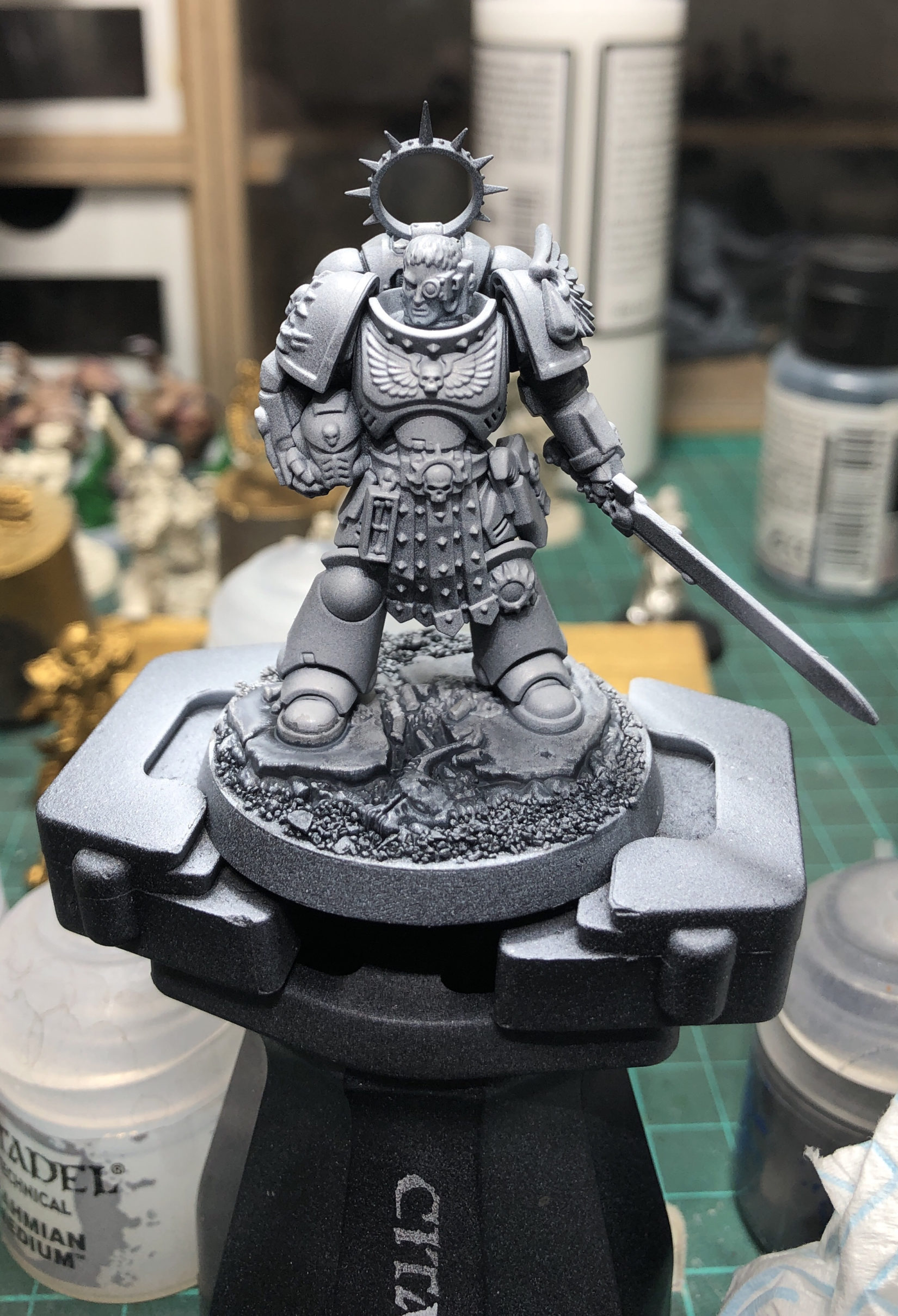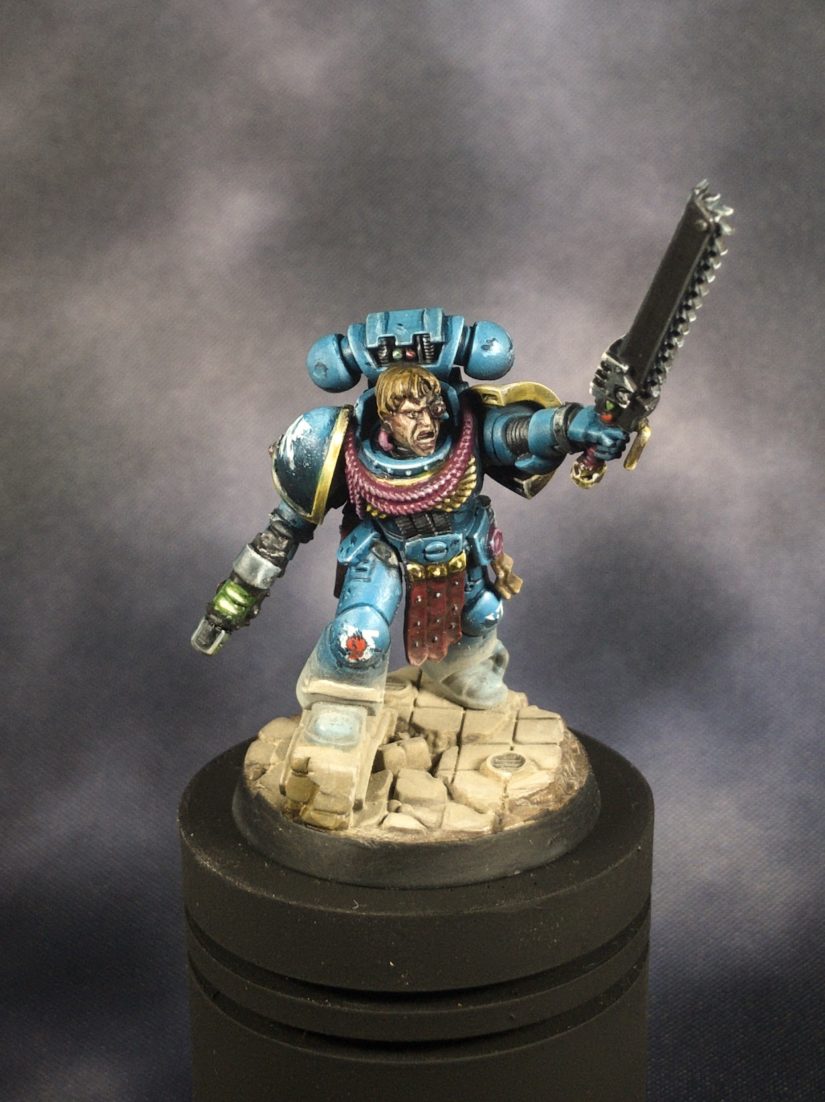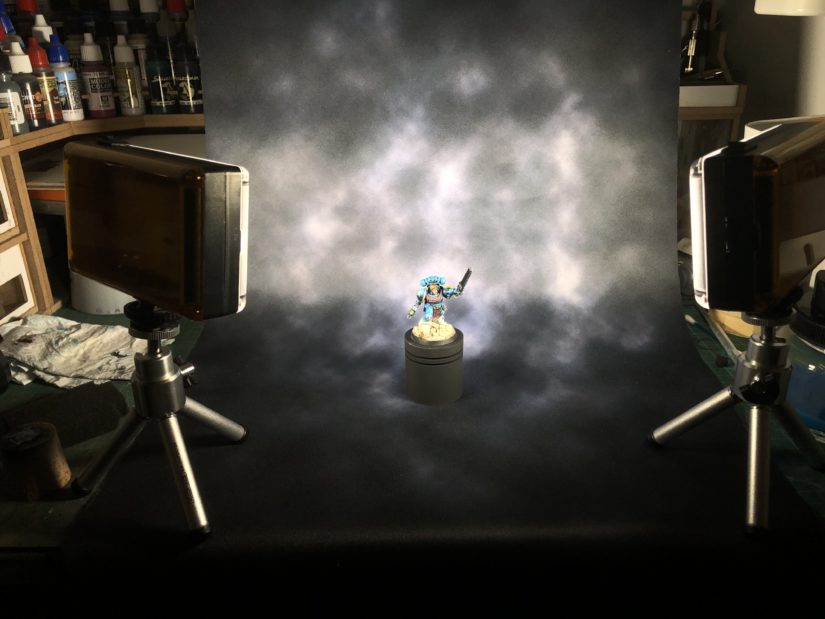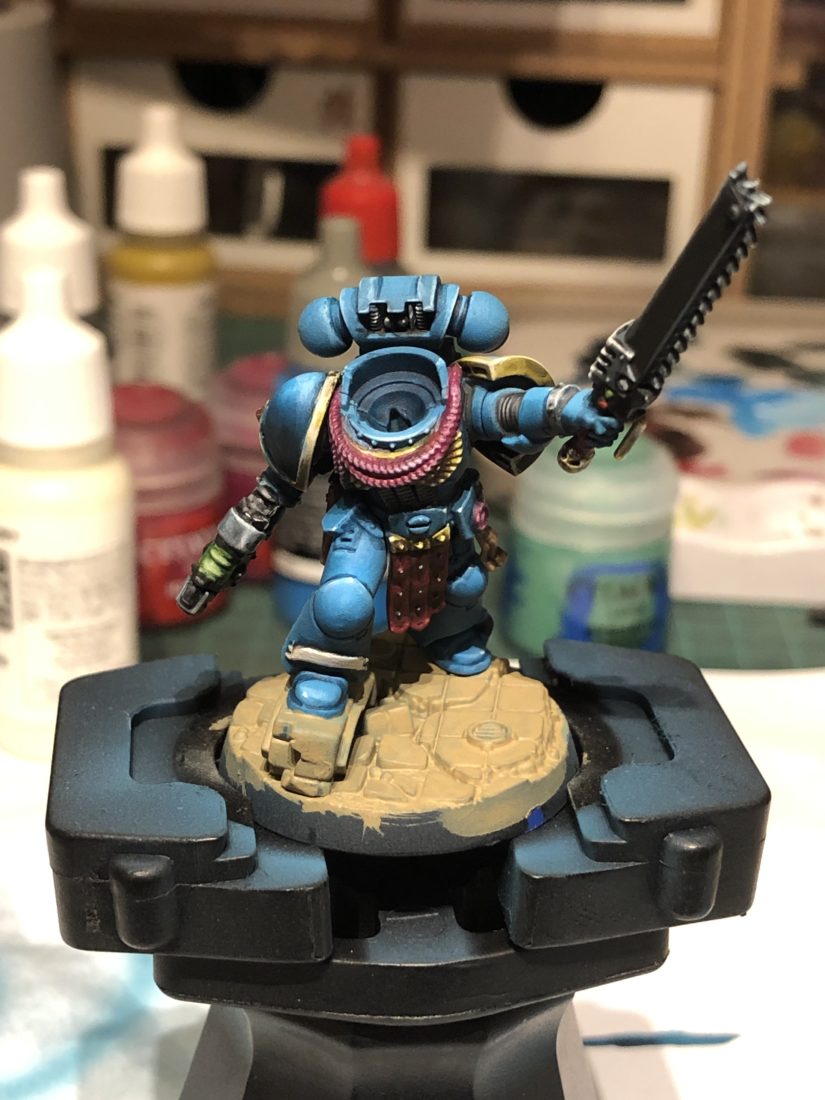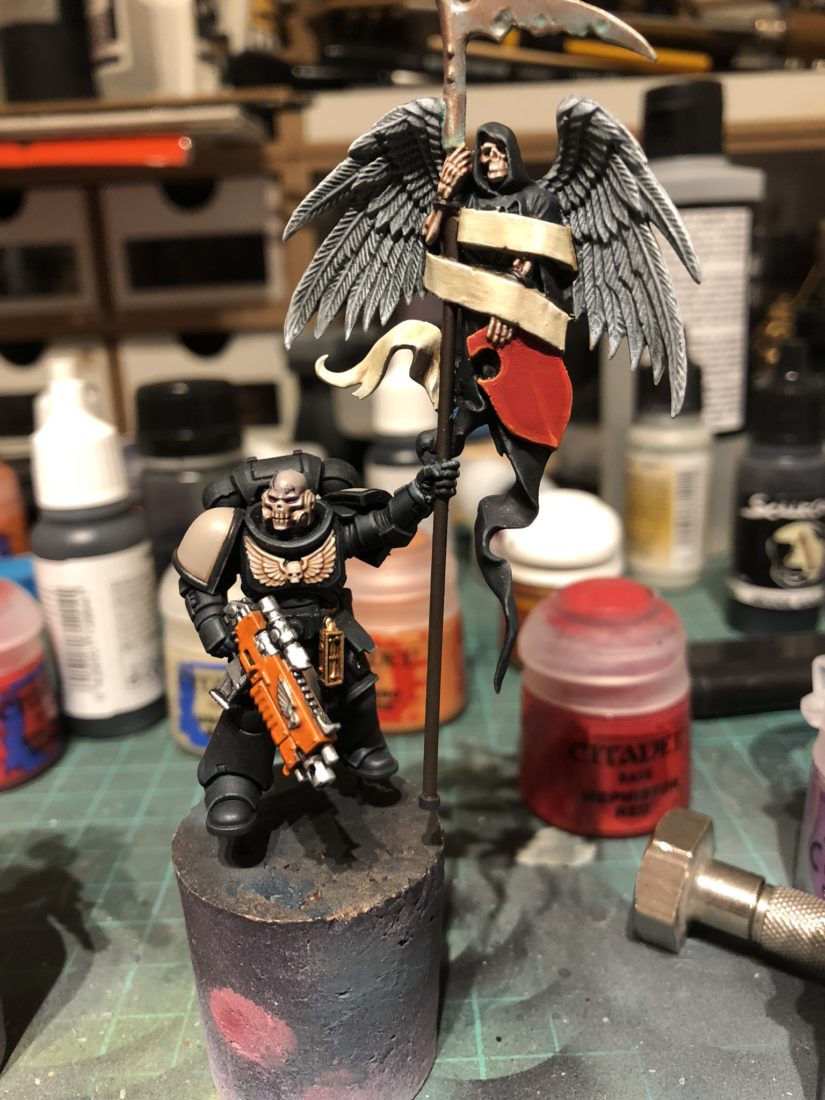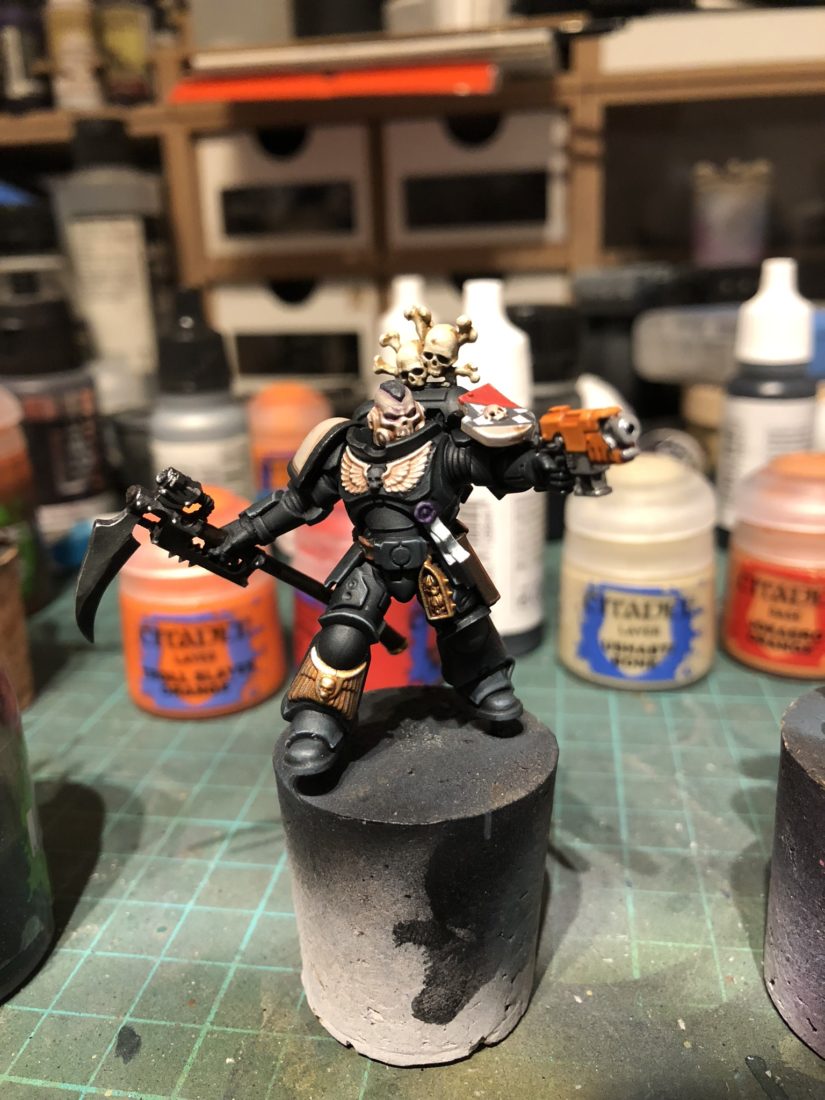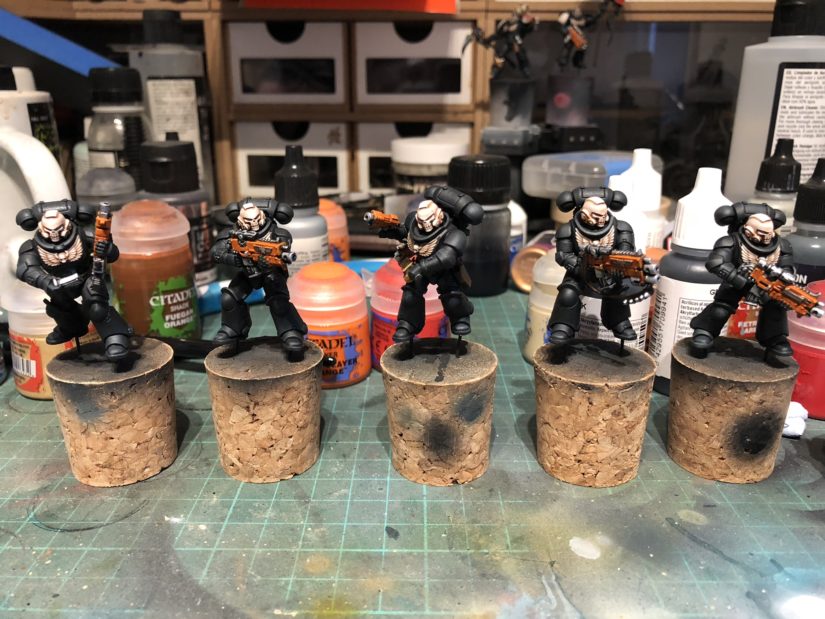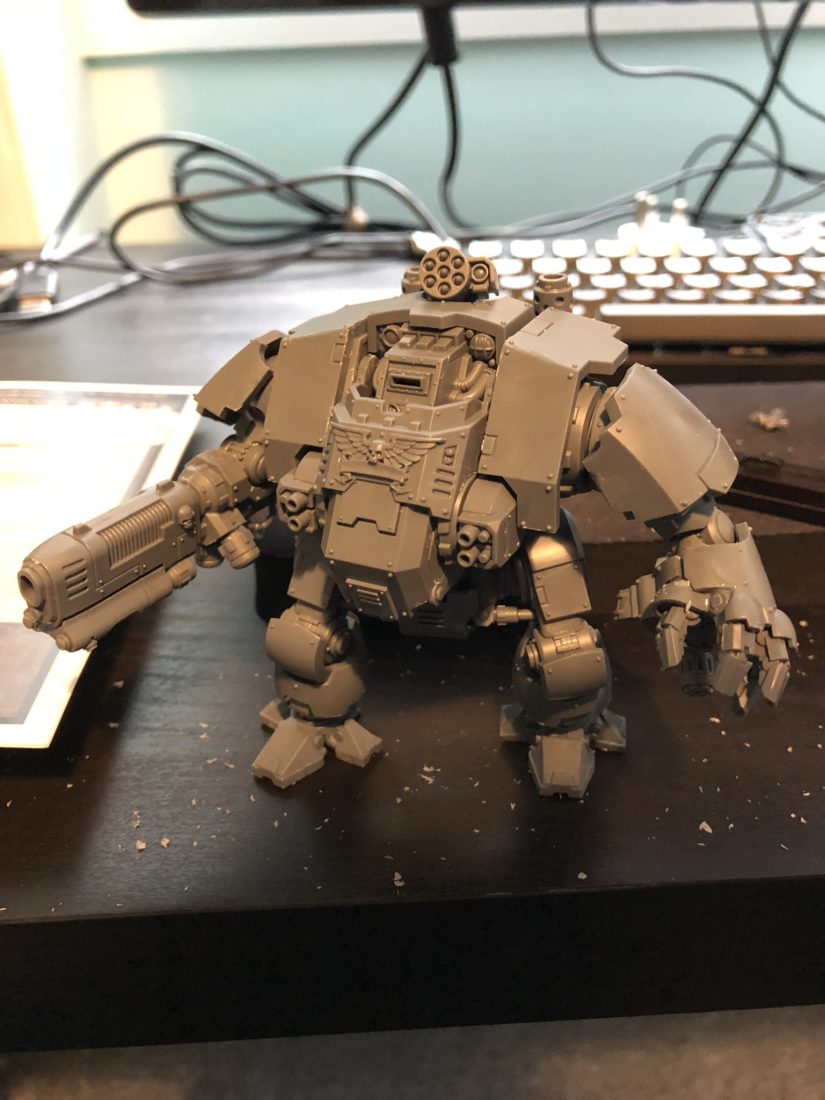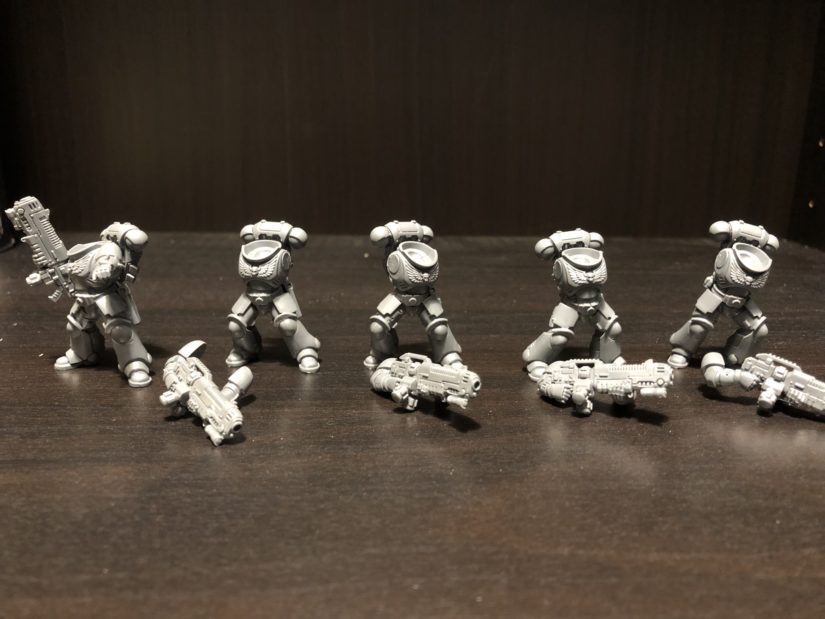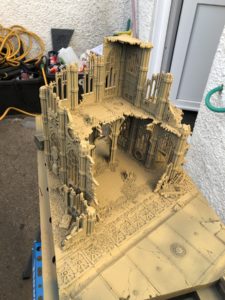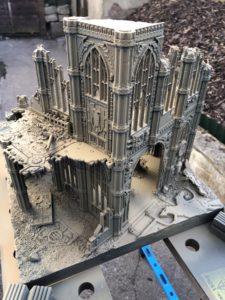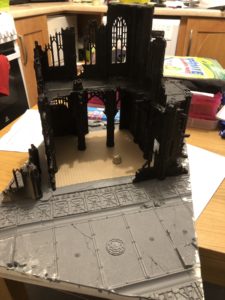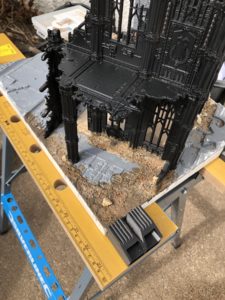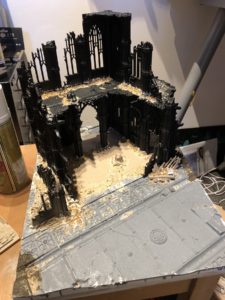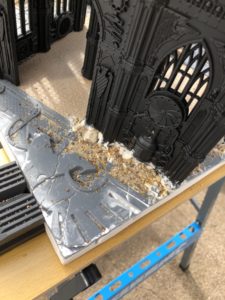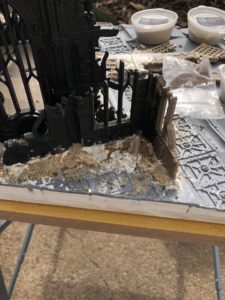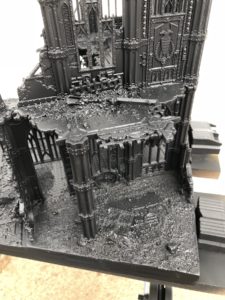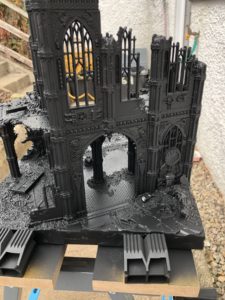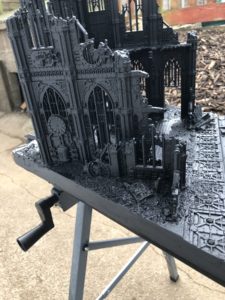This would have been my #Everchosen entry, but life got in the way. I’ve finally got around to adding the zenithal highlight of white ink. I’ll hopefully get around to actually painting it soon! #miniaturemonday #paintingwarhammer
The first batch of Primaris Space Marines are just about finished, with just a few details and the decals to finish before basing.
One of the choices I had to make was what secondary colours to use for contrasting and spot colours. The main armour is fairly monochromatic, being essentially black and bone-white. The main contrast would come from the gun casing, for which I chose a fairly bright orange. Orange isn’t a colour often seen on Space Marines, so this in itself helps the models stand out. To offset this, purple was added as a spot colour, used on lenses and purity seals.
I decided these marines would be from the 3rd Company, so red was also added to the palette. Each marine will get a red trim added to one knee (still to do), and the shield of the Ancient was painted red to match this.
The Lieutenant was given some basic freehand on his tilt-shield, also integrating the red of the company. I’m not happy with the blade of the scythe, so I plan to repaint it.
The Intercessors finally received their helmets. Once the shoulder pads are added, I think these will look quite intimidating on the tabletop!
With the first batch nearing completion, I needed to start preparing the next wave! Needing a break from Intercessors, I decided to build something fun – a Redemptor Dreadnought. This kit was a joy to build, going together in just a few hours. Many of the parts are designed to remain unglued, so they can be reposed. I didn’t bother with this, as it would make things more difficult to paint. A couple of parts are unglued for now so I can paint them seperately.
With the Dreadnought assembled quicker than I thought it would be, I moved on to some Hellblasters. I have to admit I think I prefer this kit to the Intercessors. I might swap some of the bodies around between the two kits.
With these built, I just need to build five more Intercessors and I’ll have everything for Armies on Parade assembled. I might make these from the models found in the 40K starter sets, to add some variety. My plan for the wider army is for each ten-man Intercessor Squad to be half multi-part kit, half “easy to build,” so there is a better mix of poses throughout.
The first of many updates on the progress of painting everything for Armies on Parade.
I finally managed to get hold of a can of Zandri Dust spray, so I was able to finish the base colour of the board. Everything was sprayed lightly from above, leaving the grey showing in recessed and in random areas of the walls and roads. The important thing was to make sure it wasn’t uniform, for a more natural appearance.
As luck would have it, the sun was setting as I took a picture of my progress, giving me this shot of the building glowing in the sunlight:
From the other side, things looked a lot more washed out:
The marines started to get their base coats and initial airbrush highlights.
At first I wasn’t too happy with how things were looking, but after sleeping on things, and adding in a few more highlights to the characters, and spots of other colours, I’ve come around to how they look.
I’ll be giving them an all over wash of black ink, to give more shading, contrast, and richness to the colour. That should help a lot, even before I add the remaining “main” colours.
Over the weekend I plan to build the remaining marines (5 Intercessors, plus 5 Hellblasters), and the Dreadnought. If I can get the black armour finished on everything in the next few days, it frees me up to concentrate on other details and finishing the board.
Only 36 days to go!
An important milestone has been reached in my Armies on Parade entry – the majority of board construction is finished, and painting has begun! It’s still only a few layers of paint, but every bit counts when there’s only 39 days to go!
I primed the main building separate from the rest of the board, so I could reach tricky areas easier. I then glued it to the board.
As the Sector Imperialis boards have a tonne of moulded detail, I had to find a way of hiding gaps between the walls and the ground. This was done using a combination of Polyfilla, textured paste, and various grits of sand and gravel. I managed to enlist a couple of small helpers with this, asking them to take some of the grit and (literally) throw it around the building — something which they quite enjoyed!
Once this initial layer was dry, I added some larger dollops of filler, and pressed a variety of objects into them: leftover floor sections, pieces clipped from spare wall sections, plastic H-beams, and a number of skulls. These then received the same shower of grits. These represent piles of larger rubble which have been pushed out of the way to make the building somewhat usable as shelter or storage.
The next morning, once the filler had dried overnight, all of the grit was covered in Terrain Fixer and left to dry for a couple of hours. Then, it was on to priming! The pictures below show the board from all sides, so you can see the details.
Yes, I intend to fix that gap…
Priming the rest of the board finished off the can of Chaos Black I’d started with the main building. With the undercoat dry, I started the first layer, based on Peachy’s Kill Team board recipe, by spraying everything Mechanicus Standard Grey. Oddly, this only took about a third of a can.
With the main board making progress, it was time to move on to the other elements. the barrels, crates, and barricades all received a coat of Mechanicus Standard Grey, apart from two of the barrels which were sprayed Corax White.
But an Armies on Parade board needs an army, doesn’t it? I finished assembling the first Inceptor squad, before priming them along with the Lieutenant and Ancient I’d previously made. The shoulder pads and helmets are separate for now, as they’ll be primed a lighter colour.
I laid out the rest of the scatter terrain I envisioned, and used some stand-in miniatures to approximate how I wanted the army itself to be displayed. All in all, I’m pretty pleased with how things are looking. Now I’ve just got to finish everything! But at least I have a plan to work to…
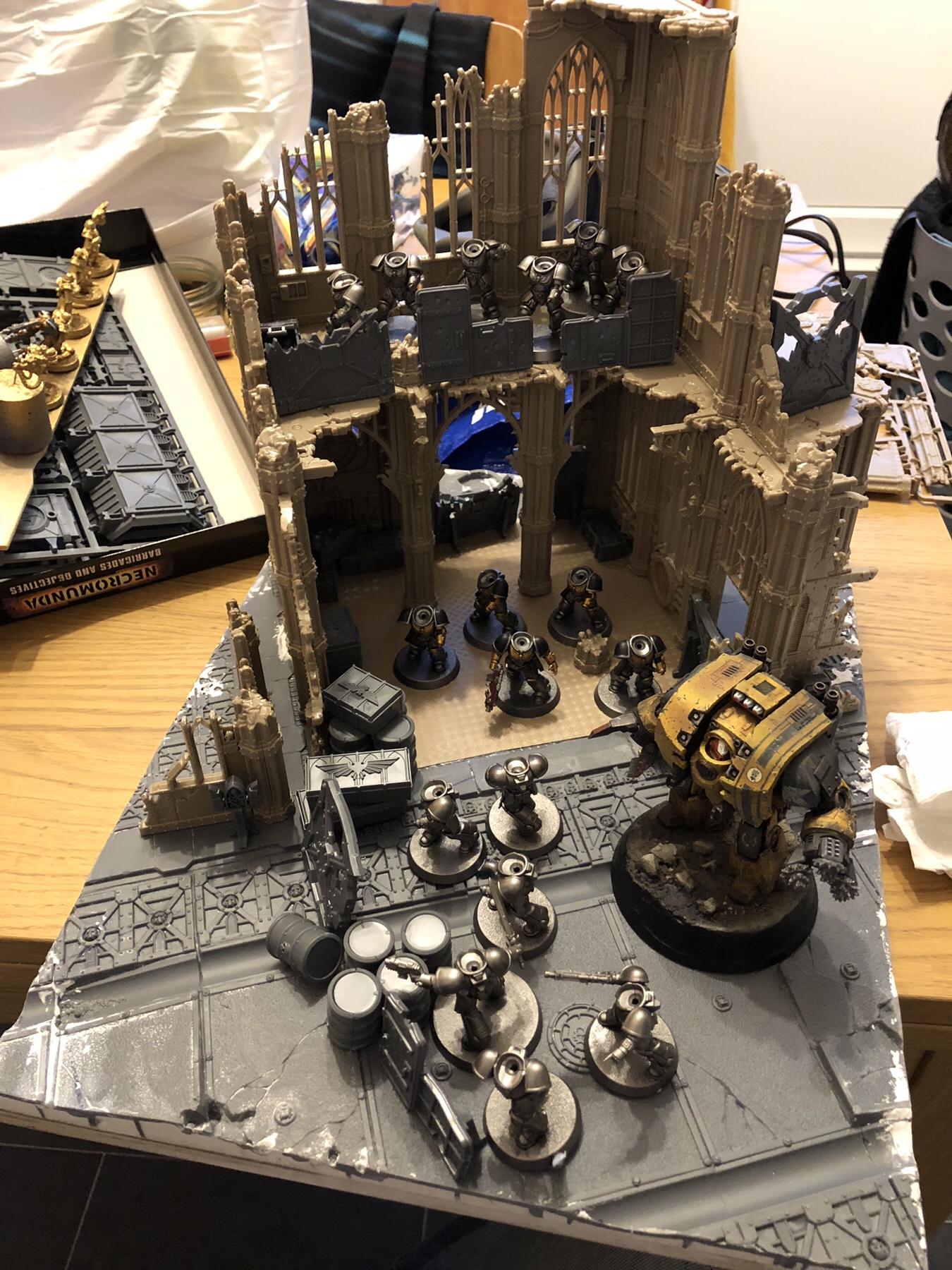
I’ve finally filled in the missing corner. Everything has been cut, glued, clamped, and filled… I’ve just got to sand everything down to size.
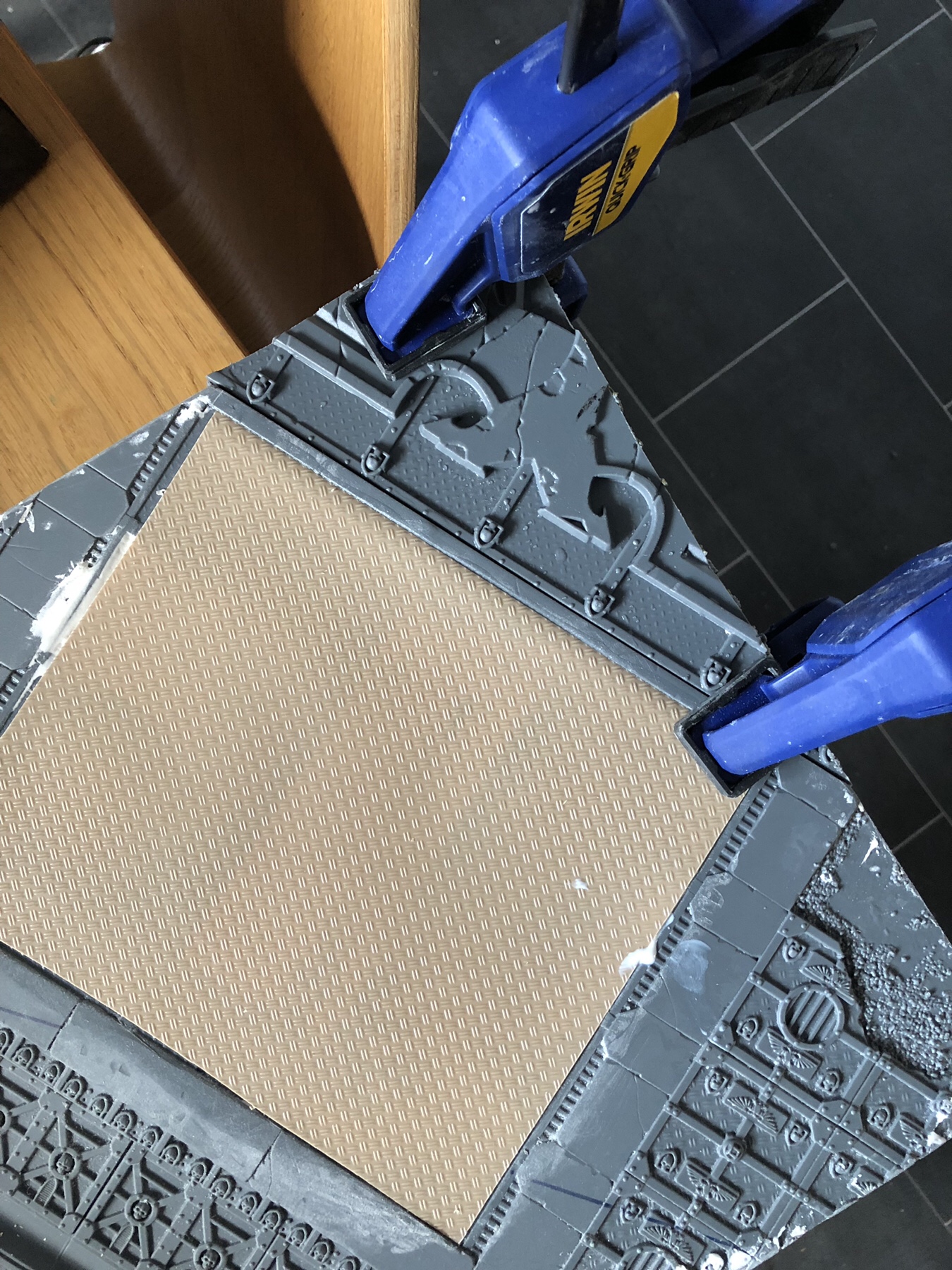
Last, but not least, the main building feature is 99% complete. I might add a couple more bits of broken columns, and there’ll be some rubble added to the floor on the board, but otherwise its ready for the next stage.
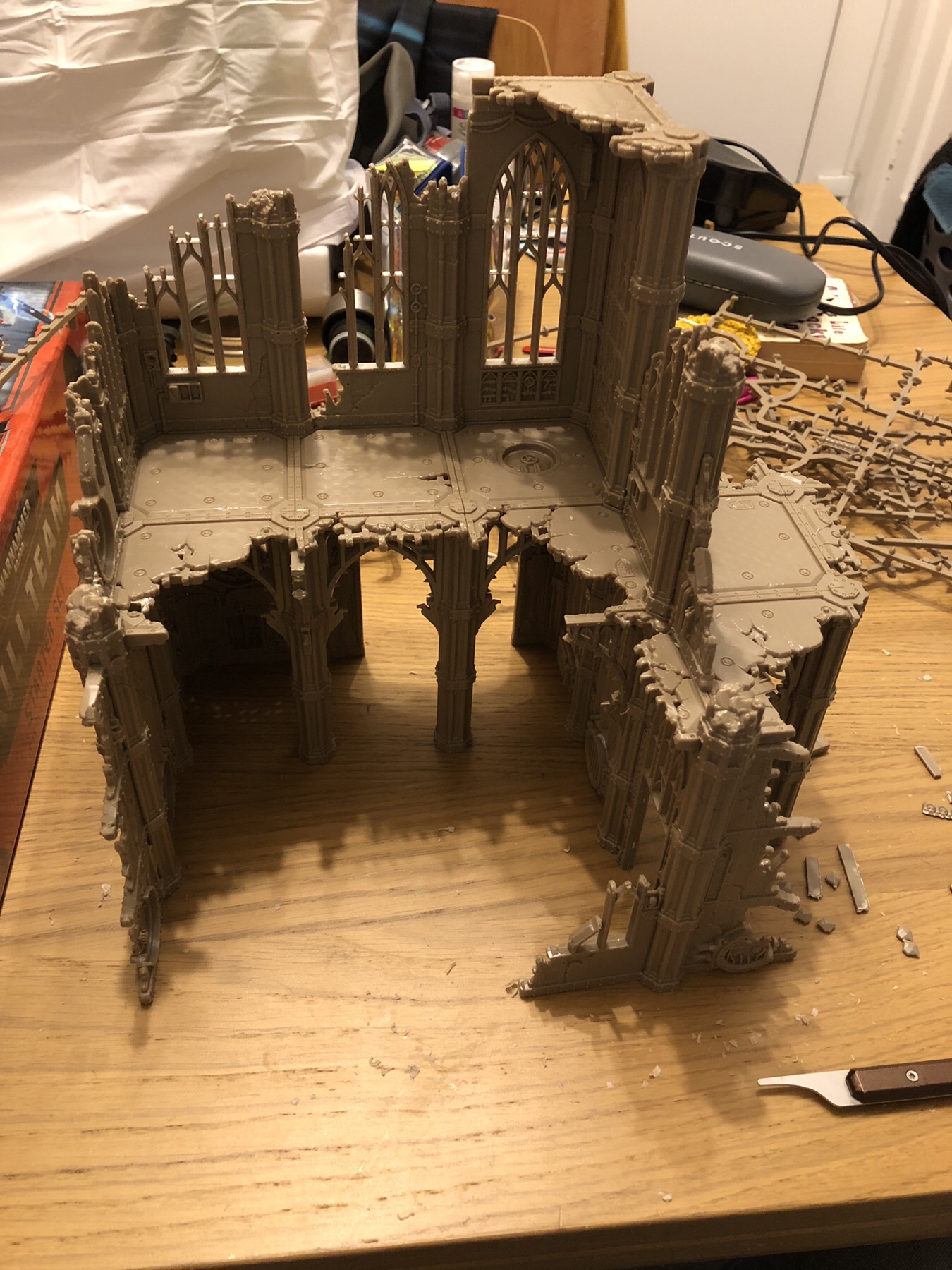
It’s bigger than I realised during assembly, running nearly the full width of the board, even when set at a diagonal. It’s almost amazing how the scale seems to change as soon as it’s placed on the board. Suddenly it becomes this huge, looming, monster towering over the battlefield.
I’ll be adding rubble and scatter terrain to break up the rest of the board, and make it look more “lived in”. Everything will be integrated using texture paint and extra grit and sand for variation. That’s the next task.
44 days to go.
I’ve been slowly chipping away at my Armies on Parade board over the last few days (when I’ve resisted the siren song of Warcraft…). The army itself is another matter, but that’s for another day.
Basic construction of the base has been finished, apart from that one empty corner. I’ve got a couple of ideas of how to fill it, I just haven’t settled on an option yet.
I started off by gluing the section cut from the Realm of Battle board to the plywood, and clamping everything together. Once the glue dried, I covered the sides and holes in the board with a hefty amount of Polyfilla.
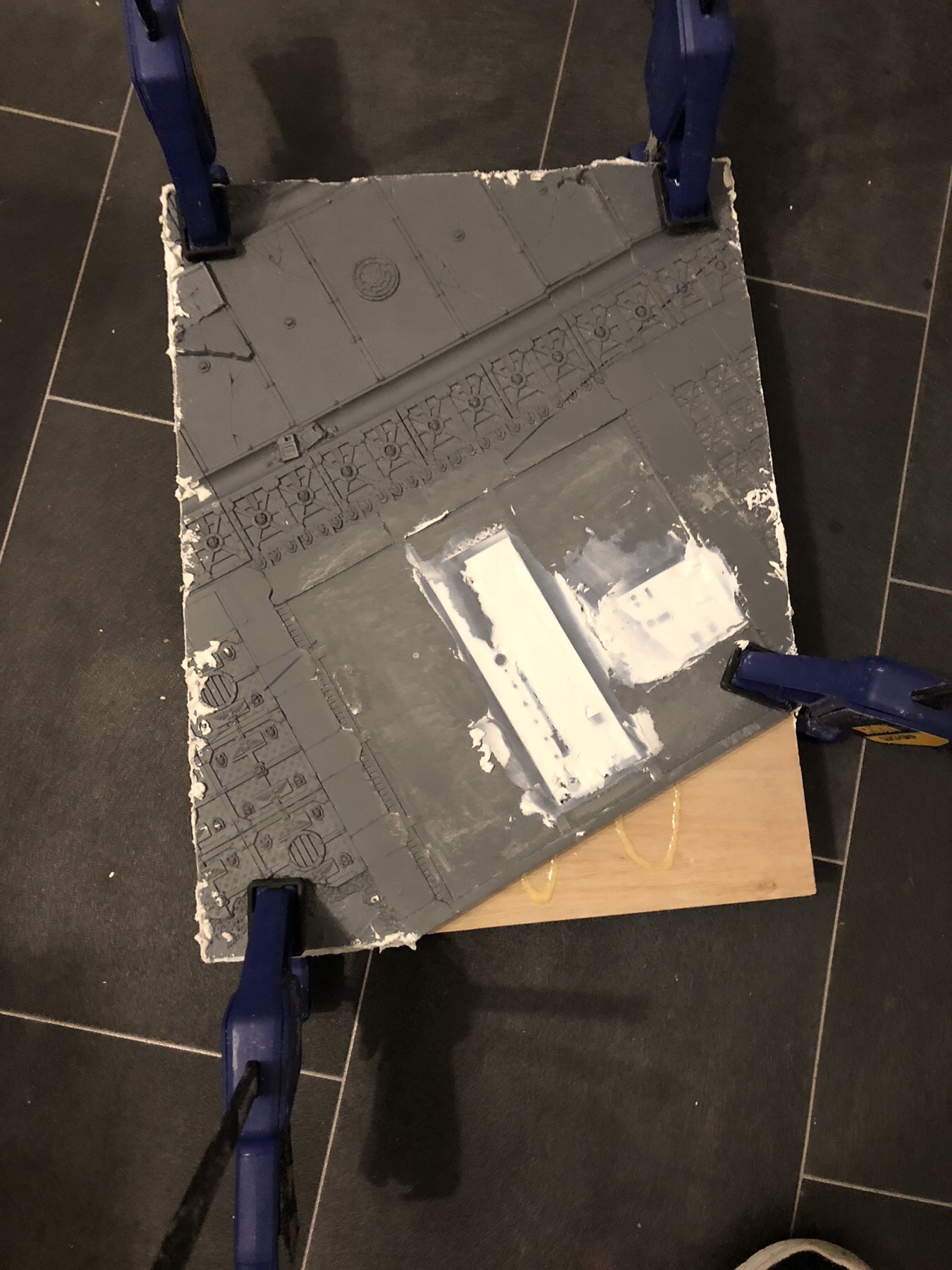
After leaving everything overnight to cure, I used an electric sander to smooth everything off and trim off the excess plastic. A new floor for the main building area was created out of textured plasticard.
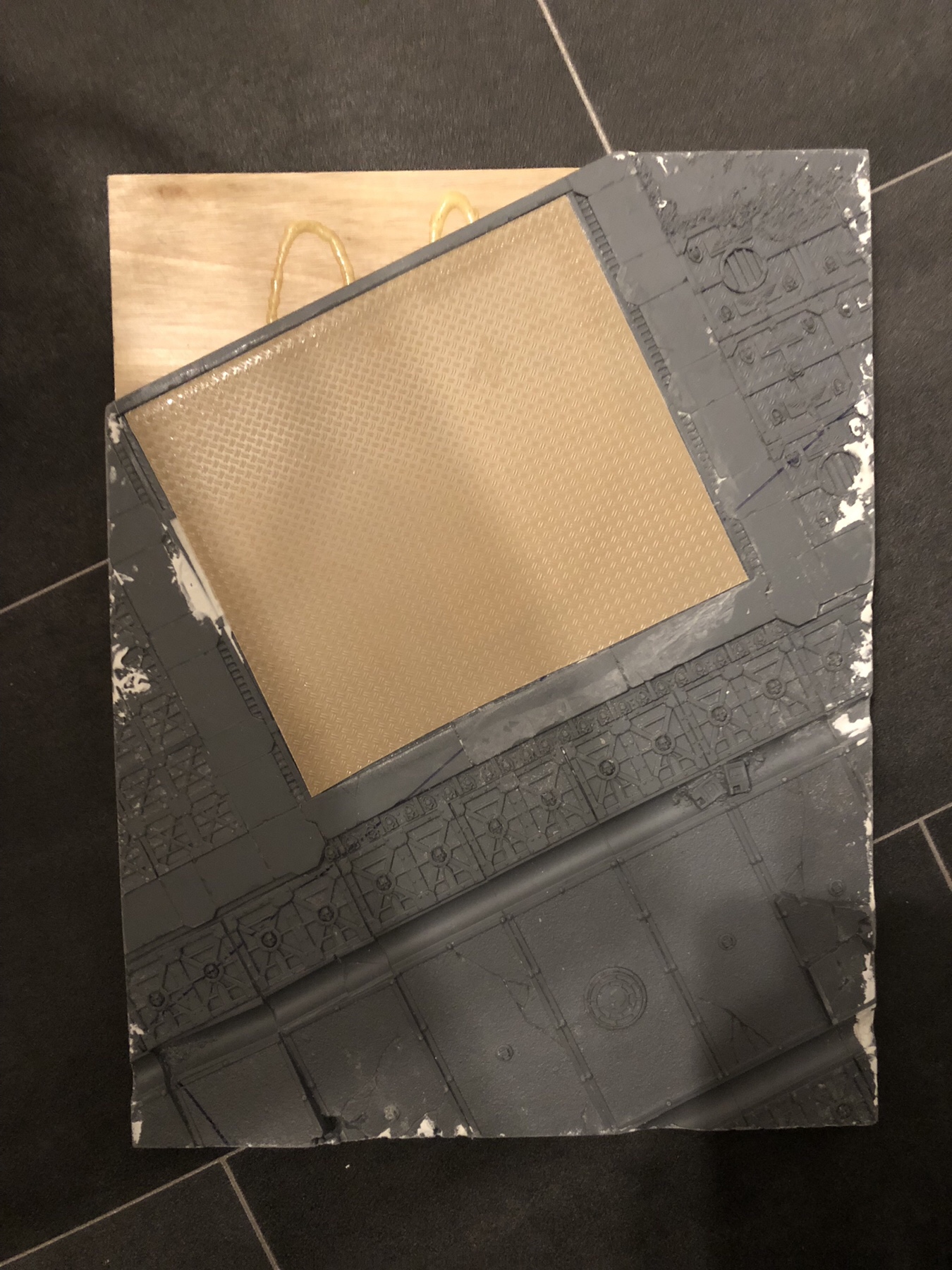
Time to check everything would fit into the case, and to see how tall I could make the buildings. It turned out I had 11.5 inches in height I could use, which was plenty. The new Sector Imperialis buildings are ~5 inches per level, so I could comfortably fit a two-story building into the case.
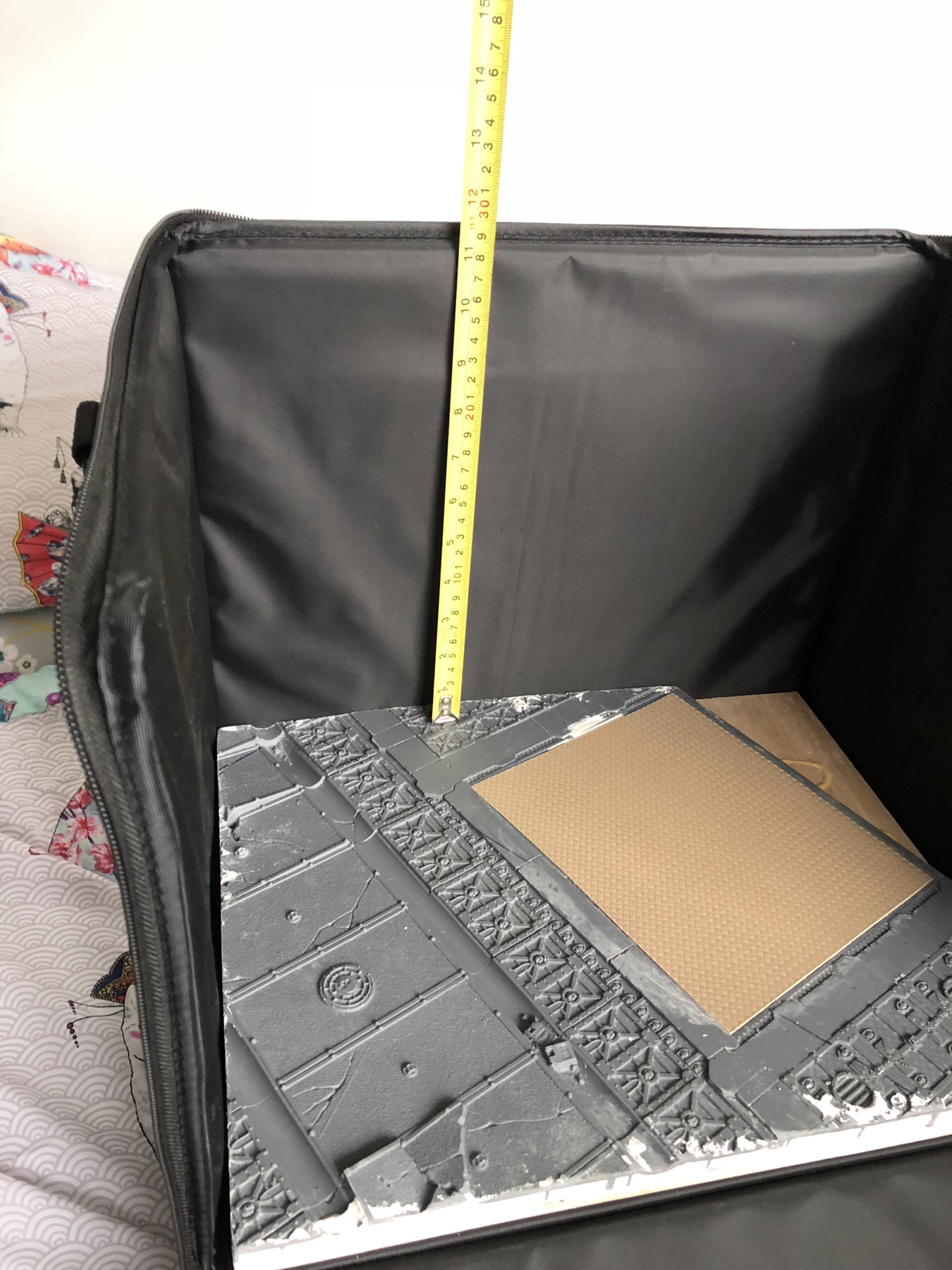
Now it’s on to the fun stuff – the buildings! I started by laying out a rough floor-plan, to see how many sections I needed per side. I ended up not using all of the sections on the left side.
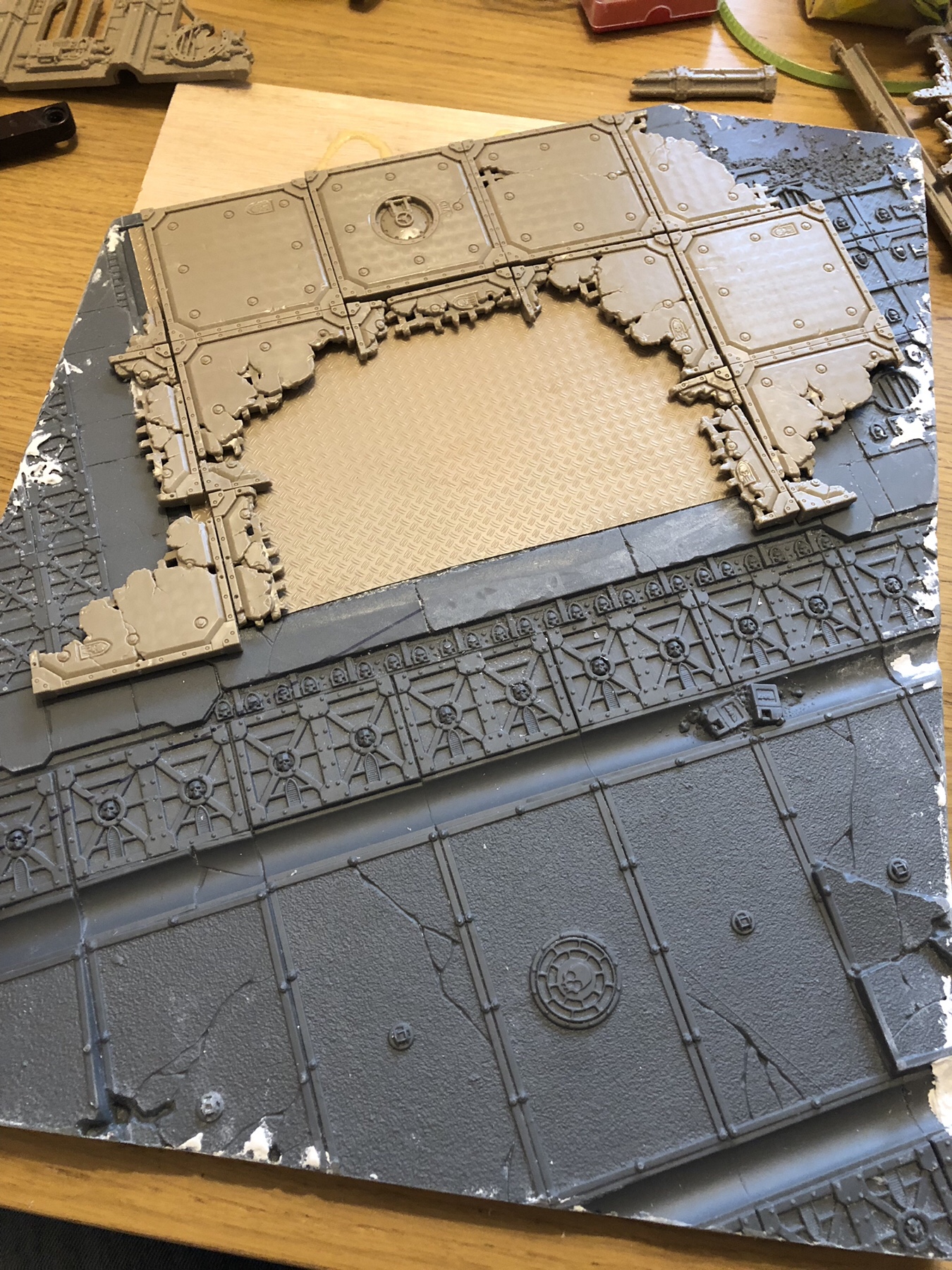
With two sides built, things are starting to take shape. I removed the door built into one of the wall sections, to give another “access point” to the building.
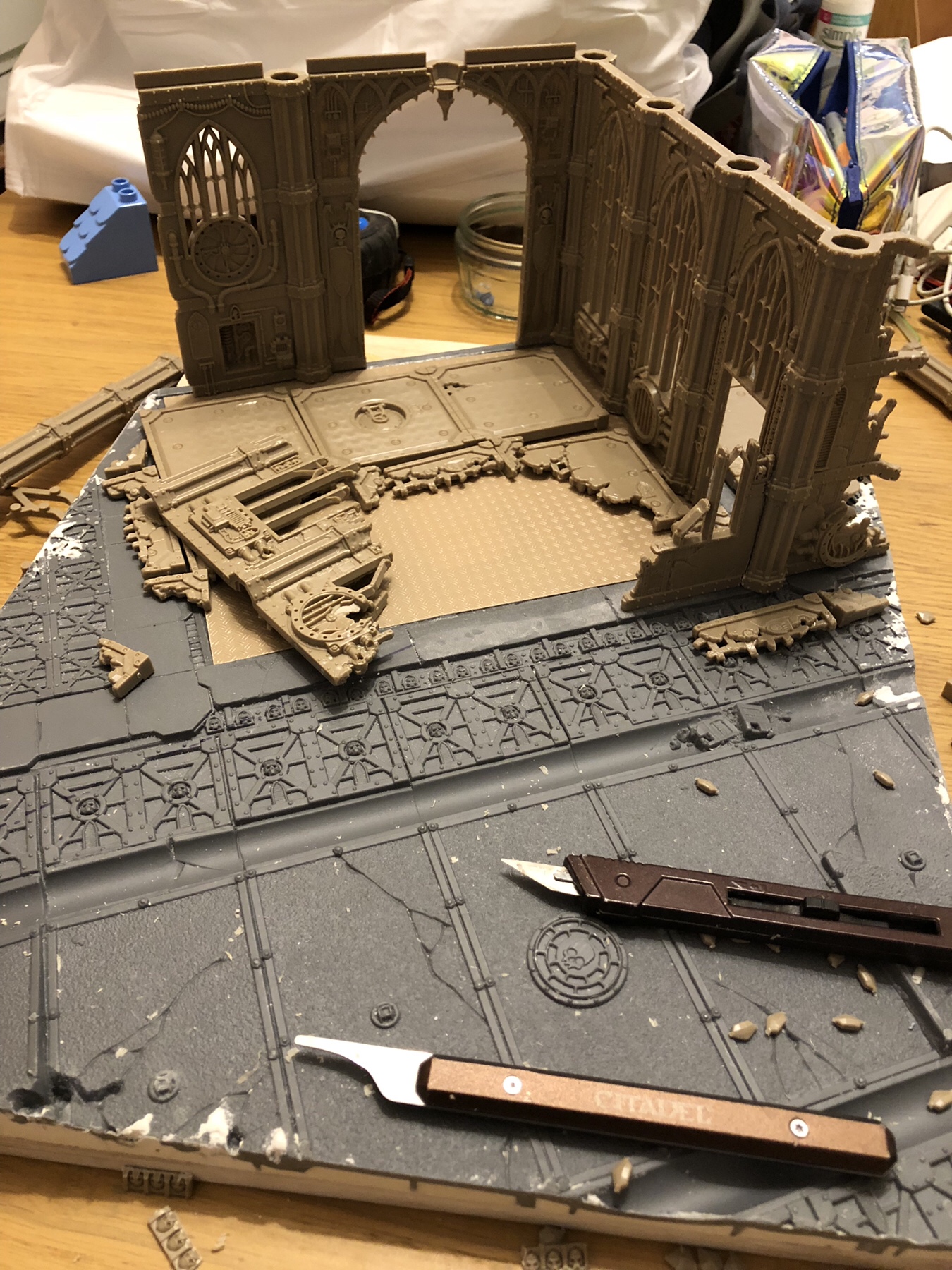
Here I’m test fitting the upper floor, to make sure everything is square. As I’d been using a spare floor section to try line-up the wall sections throughout, things were pretty good.
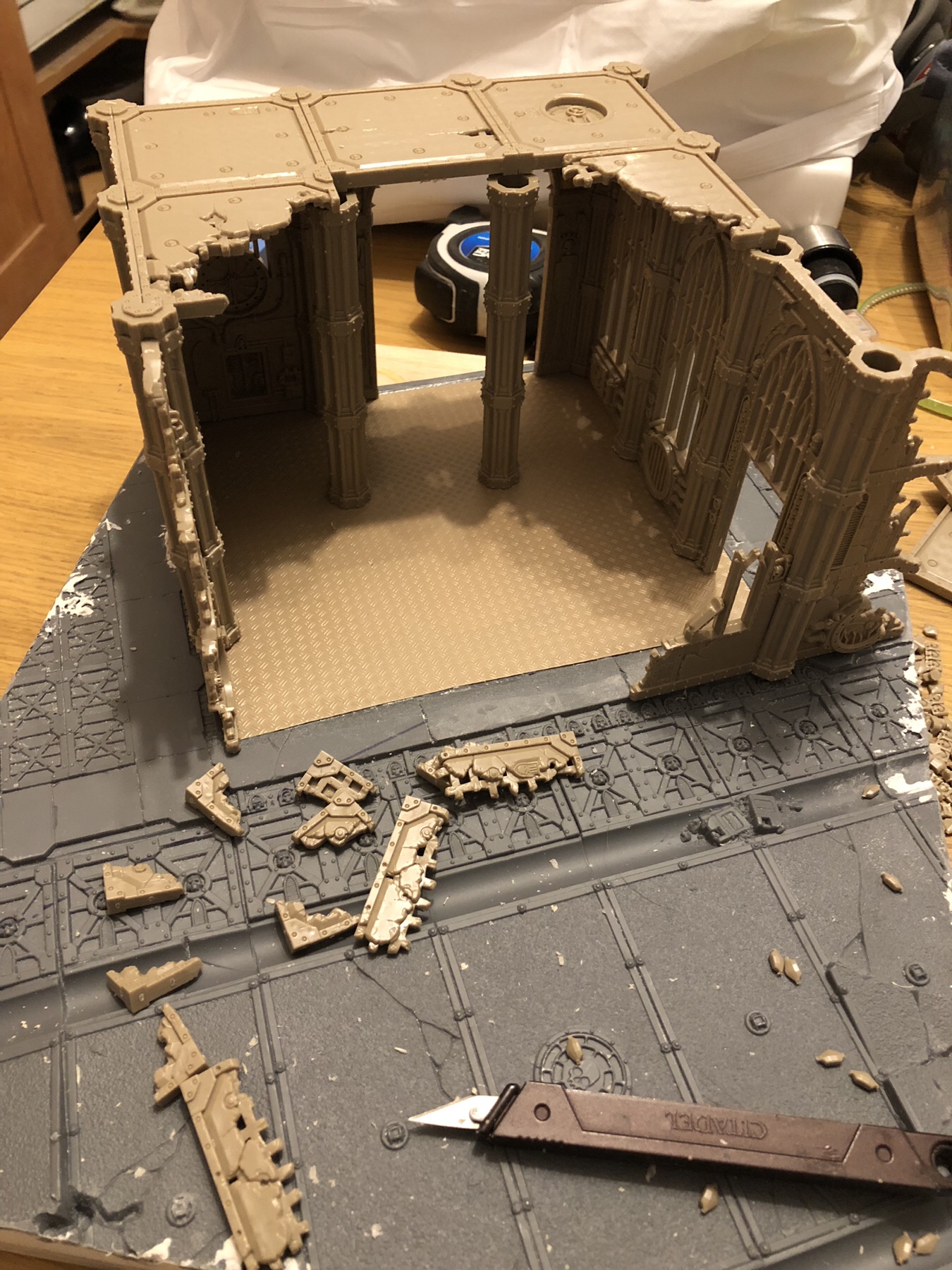
By this point I was starting to think about the walls on the upper floor, but it was time to pack everything away for the night. Shortly after taking this picture, I realised I had to rip the column tops from the right-side wall as I remembered I was going to extend the floor out that way.
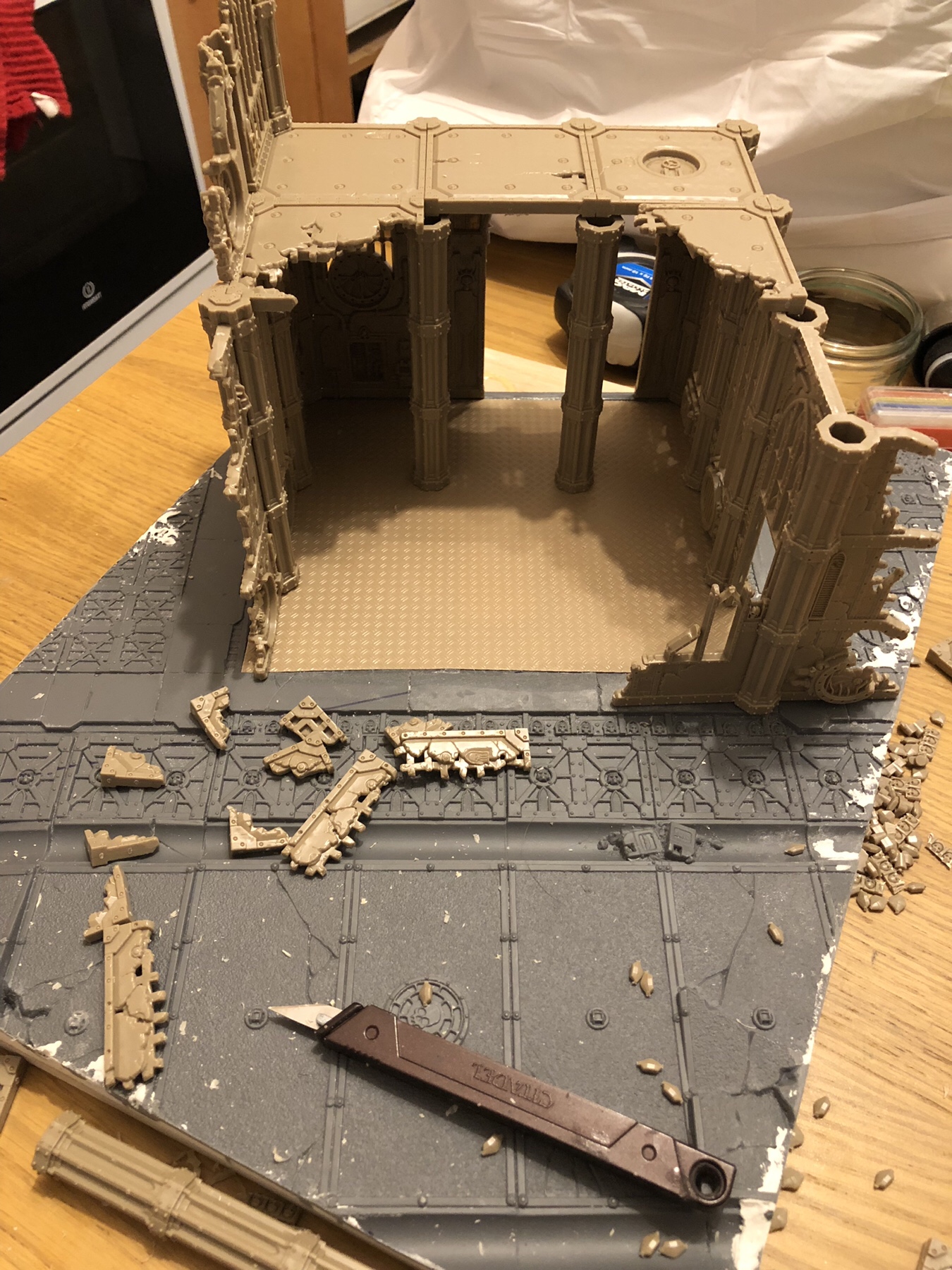
This is the mess from just from scraping off mould-lines in one sitting. Time to get the vacuum out…
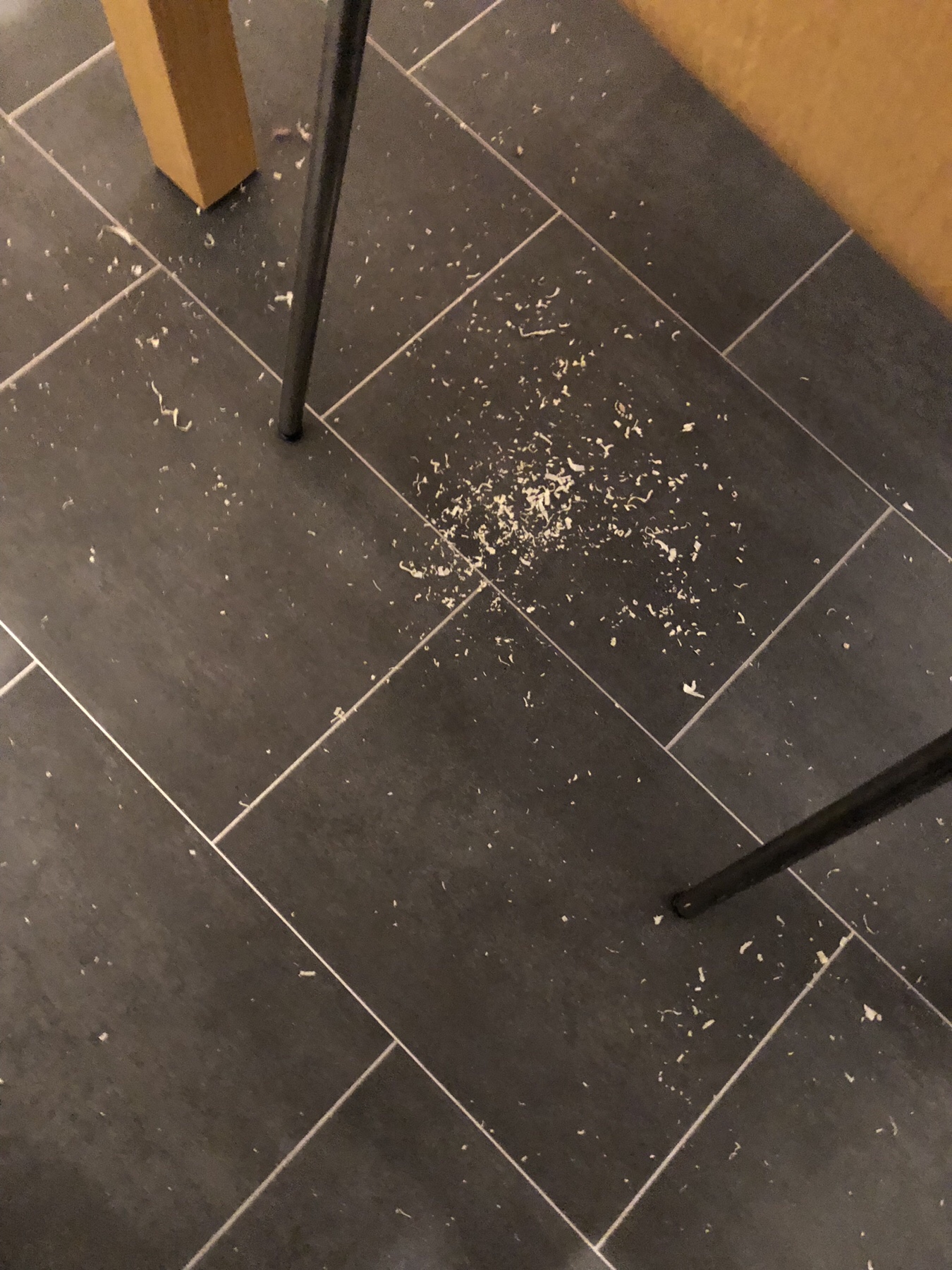
My plan is to finish construction of the buildings and ruins this evening. Providing I get the missing corner filled with something, I might manage to get the first layers of paint on the board by the start of next week. I really need to get the board finished soon, so I can move on to painting the army. There are only 45 days to go until Parade Day!
This is part 2 in a look at the changes to our hobby I have witnessed since my return at the start of the year. You can find part one, which looks at the changes in game-play here: On Returning to Warhammer 40000 – The Game. This part is a bit more ranty.
By far the biggest change I’ve noticed is in the general attitude and culture surrounding the game. In many senses it feels less like a hobby, and more like a competition. There seems to be a “win at all costs” mentality in a large section of the gaming community. I don’t want to sound like someone espousing about the “good old days”, but I find, particularly amongst the younger players things are a lot less friendly than they used to be.
Everywhere I look I see people asking for advice on building lists to beat their local “meta” (WTF?) – what happened to playing the game for the enjoyment of playing the game? I get that winning is fun, but it’s not everything in Warhammer 40000. Our game is as much about telling stories as it is about playing to win. It’s why I’m so glad to see the focus on “Telling a Narrative” in the new rulebook.
By all means, play to win, but if your opponent hasn’t still enjoyed him/herself while losing, then you’ve both failed in my opinion.

Another cultural change I’m not so keen on is the rumour-mill on the Internet, and the general sense of… entitlement that the more vocal side of the community displays. So you don’t like a miniature? That doesn’t necessitate a profanity-riddled screed about how the model sucks, GW sucks, you’re never going to spend another penny on their products again, an you could have done so much better while blindfolded and with both arms cut off… and so on, and so on. Put your toys back in the pram. Don’t buy the miniature – or, if for some reason you are “forced” to – convert it; change it to suit your tastes. Just stop complaining about it. Likewise, when a rumour turns out to be off the mark, don’t get all tetchy. It was just a rumour, after all!
Relatedly, your army (or an opposing army) is not “broken”. It may need a rules update as we’re in a new rule set, but that doesn’t mean it’s unbeatable, or can’t be won with. Every codex has its faults, for sure, but nothing that can stop you enjoying the game if you don’t let it. View any such “brokeness” as challenges to be met, and a test of your skill as a player. If you can overcome a “broken” army then you can take comfort in knowing you are better than any of the faceless complainers out there.
I dislike “mathhammer” as a way of proving something is awesome or that something sucks. If you’re spending your hobby time working out a stream of maths over the chance or likelihood something will win you your next game, then it’s not a hobby any more. Take what you’re drawn to (my armies mainly consist of what I want to paint), and just play it. Leave the maths for professional poker players!
Right, now I’ve got that out of my system, it’s not all bad, I must say. The hobby is bigger than ever. I can get tips and feedback from like minded people all across the world. I have access to a whole raft of information which just wasn’t available before.
The things I’ve noted a dislike for above are merely the dark side of the passion 40K inspires in its fans. It’s the same passion which drives us to spend hard-earned money and countless hours slaving over our miniatures and army lists. Properly channelled, that passion is what leads to amazingly painted armies and miniatures, brilliantly fun games and camaigns, and what ultimately brings players like myself back to the game after so much time away… and that is no bad thing.

I have been out of the hobby for a long time. This was made clear to me when I realised the majority of the regular players at the local Games Workshop store weren’t even born (or were still in nappies) when I last rolled the dice in anger.
When I last played properly, Warhammer 40,000: 2nd edition was still the dominant ruleset (3rd had just come out when I put down my heavy flamer template). Dark Eldar were brand new. Necrons only had about 3 models in the entire line. Space Marines consisted of: Ultramarines, Blood/Dark Angels, Space Wolves, and miscellaneous. Sisters of Battle had their own codex, and it was good. Templates were bigger. Wargear came as cards. We needed dice with more than 6 sides. The world – and the game – was a very different place.
Change is inevitable, particularly if anything is to survive as long as Warhammer 40000 has. 25 years is a long stretch for what is realistically a niche game/hobby. Off the top of my head, here are just a few things which are entirely new to Warhammer 40,000, from my perspective:
- Tau
- Grey Knights having a codex entry (with points costs), never mind an entire codex
- The Force Organisation Chart
- Deep Strike/Reserves
- Missions, objectives, warlord traits, etc.
- Flyers
Other notable changes include most special rules (sniper, feel no pain, eternal warrior, and so on), completely revamped movement rules, cover working completely differently, close combat (sorry, “assault”) changes… I could go on all day, to be honest!
Some of this change is good. Assault is generally a lot quicker and more streamlined when compared to 2nd edition. No more (as an example) Space Marine assault squads with 10 different weapon combinations, due to itemisation streamlining. Less rediculous weapon effects – prime example being armour penetration against vehicles (D20 + D4 + D6 + 10 for a chainfist… don’t even get me started on lightning claws!). Many parts of the game are more sensible than those of old. The FOC is a brilliant addition to the game in my view.
Other changes I am on the fence about… generally because it seems at times I’m rolling dice for the sake of rolling dice. Random charge/run lengths are the first thing which comes to mind. The various terrain tests are another. Random missions, random deployment types, randon warlord traits, random psykic powers, random special rules and effects, objectives… on average I find it can take around 20 minutes of faffing about rolling on various tables and setting up stuff (other than my army) before I actually get to play the game. While on the one hand it leads to more varied games, on the other it takes an unnecessary length of time in my view.
One thing I have an impression of – and correct me if I’m wrong – is that overall, points costs are lower than before. This might be why games seem to be a lot bigger than I remember. Time was you’d have ~2 squads, a character, and a cheapish vehicle in an average game (1000-1500 points or so). Now I’m seeing games with scores of infantry, a couple of characters, multiple vehicles and creatures, all at around the same points level as before. The jury is still out on whether I see this as a positive change.
Nightfighting I hate with the heat of a thousand burning suns! But that’s just because I’ve never really wrapped my head around it in a way that doesn’t have me reaching for the rule book every 5 minutes.
Originally this post was a lot longer, and took a look at the cultural changes I’ve seen within the hobby since my return, but I decided it would be best to split this off into its own post, which you can read here: On Returning to Warhammer 40000: The Culture.

 Last weekend I read the latest Horus Heresy novel from Graham McNeill and Black Library: Angel Exterminatus. What follows is a quick review. I’m trying to avoid spoilers, so don’t go into much depth about the plot.
Last weekend I read the latest Horus Heresy novel from Graham McNeill and Black Library: Angel Exterminatus. What follows is a quick review. I’m trying to avoid spoilers, so don’t go into much depth about the plot.
Angel Exterminatus focusses on the the Iron Warriors legion and their Primarch, Perturabo. Although they are the main protagonists, the plot is setup and driven by another Primarch, Fulgrim, and the Emperor’s Children legion. Also making an appearance are 2 Eldar, and a few battered “loyalist” Space Marines.
Fans of Warhammer 40,000 – and the Horus Heresy in particular – will be lured into Angel Exterminatus by the promise of finding out more about Perturabo and the Iron Warriors. Up to now they have been typecast as rather mundane, if somewhat psychotic bullies. They’re the go-to guys when you have to besiege some fortress in a crawl-through-the-mud, ground-pounding war of attrition – as opposed to the other legions who grab all the glory for daring strikes into the heart of enemy territory. Beyond this stereotype their background hasn’t really been filled in much, leaving us thinking they’re pretty boring, bitter, and only concerned with blowing things up with the biggest gun possible.
What we learn from Angel Exterminatus is a very different picture. The Iron Warriors and Perturabo become interesting, multi-faceted characters. Perturabo is an master craftsman and artisan who can (and does) design and build devices and architecture of dazzling skill and intricacy. He has an unparalleled grasp of physics, mathematics, and strategy. He also has a volatile, murderous personality, but we come to understand where it comes from, and that he is very much more than he appears. The Iron Warriors largely reflect their Primarch. They are straight-forward warriors who excel at far more than they get credit for. They are logisticians, strategists… even geologists and engineers. They just happen to apply those skills to warfare and in a manner which is blunt and brutal, but extremely effective – applying the maximum force with the least amount of effort.
The overall plot can be summarised as: Fulgrim, with the aid of a mysterious Eldar “historian” convinces Perturabo to take his legion on an expedition to the heart of the Eye of Terror, to an ancient, dead Eldar world which is home to a mythical super-weapon which could end the war quickly in favour of Horus. Some Loyalist survivors of the opening battle of the Heresy discover the plan, and are led by another Eldar in a bid to thwart this possibility. Along the way we get to find out just how far the Emperor’s Children and Fulgrim have descended into excess and the worship of Slaanesh, and also how much it sucks to be a loyalist Space Marine right now. Mid-way through the book there’s even a Iron Warriors version of a game of Warhammer 40,000.
Overall, the plot flows nicely, and works well. There a very few, minor snooze moments, but nothing which totally detracts from the rest of the story. The payoff at the end gives us several things which old-timer fans might have been wondering when they would appear in the series, leaping some plot threads considerably.
In summary I’d say Angel Exterminatus is a great addition to the Horus Heresy series. If you’re a fan then you definitely want to pick it up. Newcomers might find it a bit difficult as it refers to a lot of threads in previous books, but it’s not so bad as I would say you should avoid it. It’s still a great read… One that once I started I didn’t put down until I’d devoured the whole book.
Foreword
If it wasn’t plainly apparent, I’m a big fan of the Warhammer 40,000 game and the surrounding universe. Warhammer 40K has some of the best “fluff” in science fiction. It is vast, covering everything from inter-personal conflict within the massive cities of the future, to vast inter-planetary war never-ending. To me, it’s not “just another” dystopian future, it’s the dystopian future. Mankind stands on the brink of an abyss; the only thing stopping it from plunging head-first into oblivion are the vast armies of the Imperium of Man, where death-in-service isn’t so much an occupational hazard, as expected. You will die for the Imperium, and you’ll bloody well be happy about it.
Life wasn’t always this bad for humanity though. 10,000 years earlier, the human race was at its peak, conquering vast numbers of worlds, rediscovering forgotten technologies, and generally unifying the galaxy under the banner of the Emperor. Religion is stamped-out, cast out by secular belief in science and reason (and large amounts of military force, if required). There are no Gods. Technology is a tool largely viewed with distrust and suspicion. Leading the charge of expansion throughout the galaxy are the genetically engineered legions of the Space Marines, led by their demigod-like Primarchs – the “sons” of the Emperor, created using arcane science to lead humanity into a better future.
Chief among the Primarchs is Horus, and the Horus Heresy series of novels from Black Library tell the story of what happened when he fell to corruption and turned against the Imperium1.
WARNING Mild spoilers from now on.
Fear to Tread.
It’s against this background we have Fear to Tread.
Fear to Tread, by James Swallow, is the 18th(!) novel in the series, and the first to exclusively focus on the Space Marines of the Blood Angels legion. Other legions show up, but mostly just as plot devices. I’ll talk a bit more about that later. James Swallow has written most of Black Library’s other Blood Angels books, which try as I might, I just could not get in to. This left me a little unsettled coming in to Fear to Tread. The Blood Angels are one of – if not my most – favourite Space Marine “Chapters”2. How much? If I couldn’t finish any of the other Blood Angels novels by the same author, was I be disappointed by Fear to Tread? Find out at the end of this review.
Plot Summary
The basic plot of Fear to Tread is: Sanguinius, the angelic Primarch (no, seriously; he has wings, and he glows) of the Blood Angels, undertakes a mission given to him by his most-trusted and beloved brother Horus – not knowing that Horus has turned traitor. The mission is – of course – a trap to destroy the Blood Angels. Remember I said there were no Gods? Unfortunately that was a lie, and a secret the Emperor has kept from everybody. There are four malevolent Gods who are behind Horus’ corruption, and they’re pissed at humanity. When the Blood Angels reach the planets they’ve been sent to they don’t meet the aliens they were expecting, but the previously unknown, supernatural horror of daemons. Along the way we discover the dark secret about the Blood Angels which Sanguinius has hidden from his legion and everybody else. This secret threatens to destroy the Blood Angels and turn them into a parody of all they stand for.
Context within the Series
One of the first things to strike me about Fear to Tread was how much it references other books in the series, and even a limited edition novella which released a couple of years ago. I found this a mixed blessing.
On the one hand, it was great to see how the events in the other books are having an effect in the wider story arc. On the other, it makes Fear to Tread harder for a new-comer to just dive right in. The best example of this is the important character of Apothecary Meros. If you haven’t read The Book of Blood novella you’ll have no idea what it means to when the story mentions his time in a sarcophagus, the visions he had, or the warnings he received about Horus and the future. It’s glossed over very quickly, and is quite confusing out of context. At least with the Space Wolves we get an explanation for their presence which makes sense even if you haven’t read A Thousand Sons or Prospero Burns. Overall though, I’d say this is a relatively minor nitpick.
The Players, and Characterisation
Horus Heresy books have a lot of characters in them, including several recurring characters. If you thought the A Song of Ice and Fire series by George R.R. Martin was character heavy, you haven’t seen anything yet. Partly this is due to vast scope of the universe WH40K, and partly because of the scale of the armies and worlds involved. Fear to Tread is probably one of the “lighter” books in this regard, with only a handful main characters to keep track of.
By and large, these characters work very well, each fulfilling a purpose, and each depicting a facet of the Blood Angels “persona” fans have come to know over the years. If anything, the Blood Angels of Fear to Tread are a little more “fun” than those we see in later stories (later in the 40K timeline, that is). These Blood Angels aren’t so much the “emo vampires in space” stereotype I’ve seen other reviewers mention when introducing Fear to Tread. They’re a brotherhood who will bend the rules sometimes for each other, when they feel it is the right thing to do; they’re noble and heroic, willing to risk their lives for just a handful of trapped survivors; on the flip-side, they are absolutely Angels of Wrath, capable of such extreme violence it even makes the “barbarian” Space Wolves take pause3.
Sanguinius would be a hard, complicated character for any writer to handle well (and still made likeable), yet James Swallow manages to make him relatable; flawed, but not overly so, and I found myself sympathising with the choices forced upon him during the course of the story. Not easy when the character is a 12-foot tall angel-winged super-human!
While I feel the “Good Guys” are well-rounded and relatable characters, I wasn’t so much of a fan of the villains of the story, apart from the daemon Ka’Bandha. For being a being of pure hate and violence, Ka’Bandha is actually pretty well laid out, and not the one-dimensional caricature he could have been. His scenes with Sanguinius are key moments of the book. The remaining villains are generally a bit uninteresting unfortunately.
Horus’ depiction (in the few times we see him – I don’t count him in the villains group because he’s only seen a few times) in Fear to Tread was somewhat new. Up to now, Horus has retained a bit of “tortured nobility” in his character, like he regrets the path he has started down. Here we get to see just how much of an inferiority complex he has comparing himself to Sanguinius, and more and more of the cruel, evil, twisted creature he will become. In contrast to this, the flashback scenes to times before the Heresy are quite poignant, particularly the scene after Horus is given control over all the crusading expedition fleets.
What I Liked
The building sense of dread as the Blood Angels fleet moves further into the planetary system, and encountering more and more things which just do not make any sense to them works well. You really get the feeling this is nothing they have ever faced before, and for the first time they are unsure how to meet their foe. They are uncomfortable and out of their element. Nerves begin to fray, and distrust starts to seep in. The tension does genuinely mount as you wonder just what horror will they come across next?
Swallow seems to have a knack for scene building. Every place and character within gets described in just enough detail as to allow us to picture it vividly, but not so much the story drags, weighed down by too much information.
Character interactions feel natural, and their personalities play off each other in a way I could believe in. No part of the dialog felt forced, or overwrought – not something I could say about some of the other books in the series.
It wouldn’t be a Warhammer 40,000 book without big climactic battles, and Fear to Tread does not disappoint. From the prologue to the conclusion, every battle is well written, with a good blend of pace, scale, drama, and grit. Even the smaller fire-fights – perhaps especially the smaller ones – are quite gripping to read. There were times I genuinely didn’t expect some characters to make it out alive. The confrontation between Ka’Bandha and Sanguinius (as depicted in the cover art) is particularly enjoyable, and lived up to expectations.
What I Didn’t Like/Understand
The big thing which did not sit well with me was the end of the book, when the Blood Angels end up in the Ultima Segmentum instead of at Earth, meeting Roboute Guilliman and the Ultramarines legion. I can understand how it happened from a in-world mechanics viewpoint, but I don’t get why it happened, knowing how the wider story plays out. The Blood Angels end up at Earth in time for the last battle with Horus (with Sanguinius playing a very, very, important role in that), but the Ultramarines do not. They get trapped in their far corner of the Imperium, as Warp travel becomes almost impossible. As a result the Ultramarines largely escape the Horus Heresy intact (aside from the events in Know No Fear) and lead the rebuilding after the war. So it made no sense to me to have the Blood Angels end up where they did. I can only surmise there is another book imminent which will directly follow on from the end of Fear to Tread. Unless it has a very good explanation or way to resolve this, then it just doesn’t make sense.
The Word Bearers Space Marines were pretty much unnecessary to the plot. Apart from acting as messengers, they didn’t do anything of note. We get to see one of them pining to “ascend” by joining with a daemon, but otherwise they were replaceable with some sort of “macguffin” which could have fulfilled their messenger role, and cut down the character count. In the end they come off as unnecessary and incompetent evil henchmen with delusions of grandeur.
The Space Wolves are slightly better used than the Word Bearers in that they are able to relay important information of what’s been happening outside the confines of this novel. Beyond that though, again, they don’t do much. Their plot is “hang around Sanguinius ‘suspiciously’, later give him some important information, then get butchered in a horrible fashion unbefitting their character.”
A few too many loose ends are left dangling for my liking. I’m avoiding being too spoilery, so I’m not going to say more, but (along with the above quibble with the ending) it feels like this is a “part one-of-two” story within the series.
Conclusion
It might seem from the above I have more negative things overall to say about Fear to Tread than positive. That’s absolutely not the case. Fear to Tread continues the recent trend of the Horus Heresy series getting back on track after a few fairly lacklustre books. As part of the series it is excellent instalment, and as a fan I thoroughly enjoyed the Blood Angels portrayal. The characterisation is largely top-notch, and the pacing pretty good. The bread-and-butter of Warhammer 40,000 fiction are the battles and conflicts, and Fear to Tread handles these very well, highlighting the unique ways the Blood Angels fight compared to the other Space Marine legions. There are a couple of key battles which had me gripped, frantically reading the pages to see what happened next.
Where I think Fear to Tread falls down, is reliance of other books to fill in the gaps. Compared against Know No Fear – the other recent high-watermark in the series – Fear to Tread is harder to understand out of context. This could be off-putting to the casual reader who has no earlier exposure to the series. I shan’t too hard on Fear to Tread because of this… it’s always a fine line between advancing the overall plot and making it accessible to newcomers, within such a long-running series.
If I must give Fear to Tread a rating, I’d give it a solid 4 out of 5. But more importantly for me it’s good enough it’s given me a determination to finish the other Blood Angel books Swallow has written.
And maybe start a new Blood Angels army. Again.
- As a personal side note: before this series, the Heresy was an unexplored but important part of the background of the Warhammer 40,000 setting, so it’s great to we’re finally getting to read about it. ↩
- After the events of the Horus Heresy, the vast Space Marine legions get split into much, much, smaller organisational units, called “Chapters”. So Legion = Pre-Heresy Space Marines, Chapter = Post-Heresy Space Marines. ↩
- The scene where the Space Wolves realise the levels of violence the Blood Angels have in their nature, buried underneath such a calm and noble exterior, is one of may favourite passages in the book. ↩
